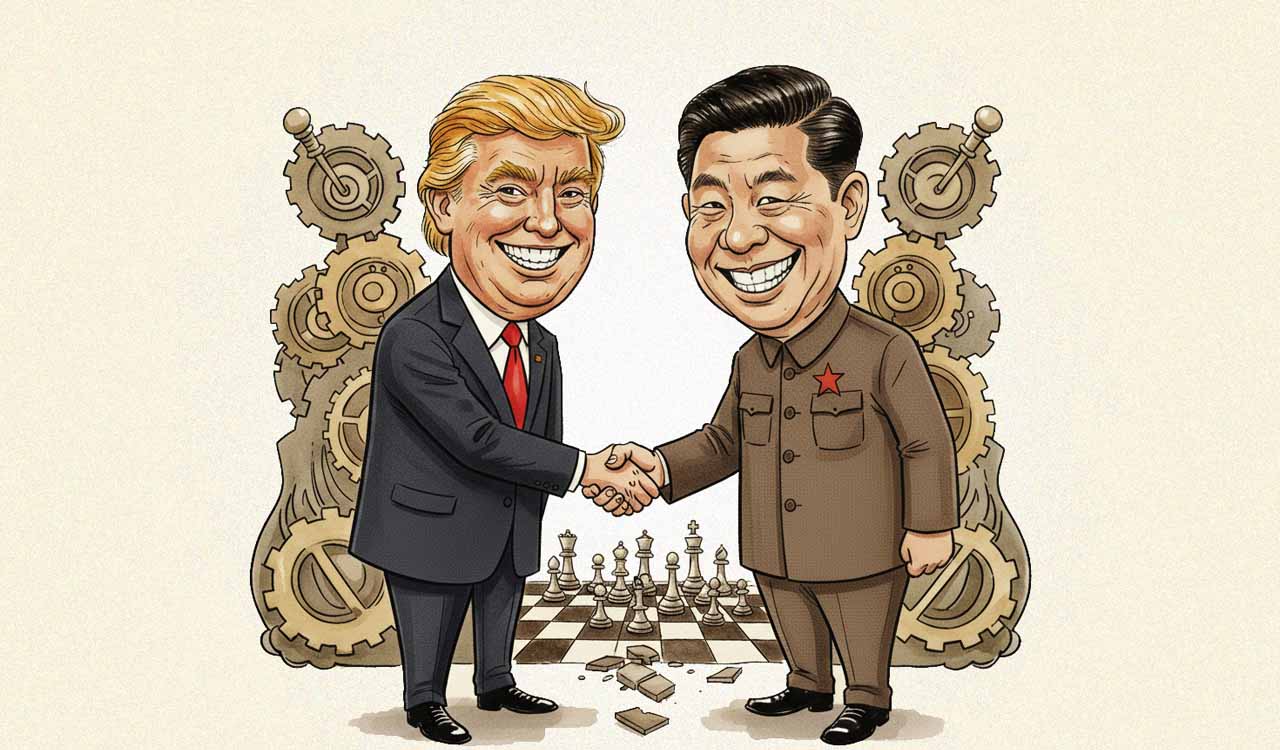Opinion: Trump-Xi rendezvous — A new grammar of great power relations
Donald Trump’s ‘G2’ remark and nuclear test claim signal a shift in US-China great power realignments

By Monish Tourangbam
Minutes before Presidents Donald Trump and Xi Jinping met in Busan, South Korea, Trump issued a startling announcement on Truth Social: “Because of other countries’ testing programs, I have instructed the Department of War to start testing our nuclear weapons on an equal basis.” “That process will begin immediately,” he emphasised.
Also Read
Fact-checkers were quick to note inconsistencies in Trump’s claim, pointing out that no major nuclear power has conducted a confirmed nuclear test since North Korea’s last detonation in 2017. The absence of clarification from the White House has left observers uncertain whether Trump was referring to nuclear-capable delivery systems or actual warhead testing. Regardless of the technical ambiguity, the timing and tone of Trump’s statement are geopolitically significant. It signals a return to overt nuclear signalling as a tool of statecraft and an escalation in inter-state strategic competition.
That this transpires in the midst of the biggest bilateral meeting since the advent of the second Trump administration, between the American and Chinese Presidents, heralds a new grammar of great power relationships.
The G2 Spectre
Just before the meeting, Trump dropped a diplomatic bombshell by posting, “The G2 will be convening shortly!” Such a reference is hardly music to the ears in New Delhi. The term G2, denoting a potential power condominium between Washington and Beijing, has long circulated in academic and policy circles as an analytical lens for the complex competition–cooperation–confrontation dynamic in US-China relations.
However, a sitting US President’s direct invocation of this acronym is profoundly significant. It signals how Washington might be reconceptualising its bilateral relationship with Beijing and marks a possible departure in the grammar of great power relations. Beyond the back-and-forth of tariff disputes and the escalating “who blinks first” game of chicken, something more fundamental appears to be shifting: the very way great powers engage in peer competition and seek status recognition within the international system.
The assertion that “a great power is a great power when it is recognised by another great power as a great power” encapsulates the tautological logic of status and recognition that underpins great power politics. In this light, Trump’s evocation of a potential “G2” with China in a dyadic framing of US-China relations may signal an embryonic shift in the American strategic lexicon.
During Trump’s first term, Washington’s national security strategy pivoted decisively from countering non-state actors to engaging in long-term strategic competition with state actors, with China explicitly identified as a “near-peer competitor.” The Biden administration largely inherited and institutionalised this framework, defining China as the only state with both the capability and intent to challenge US primacy in the international system.
Yet, the tone and texture of Trump’s approach differ markedly from Biden’s. While Biden’s team cast the new great power rivalry as a systemic struggle between “autocracies and democracies,” Trump’s foreign policy emphasised hyper-transactionalism and a hard-nosed contest over trade, technology, and burden-sharing, often at the expense of alliances’ sensibilities. This approach reframed US-China relations not merely as an ideological confrontation but as a negotiation over relative status, economic advantage, and strategic hierarchy.
The world stands at a historical precipice, where the established rules of economics, security, and technology are being rewritten even as developments outpace the capacity of states to negotiate new terms of engagement
In this sense, is Trump’s “G2” moment an accommodation of China’s rise or a performative assertion that the US retains the prerogative to define who qualifies as its peer? Regardless of the answer, it is indeed a point of departure in US-China bilateral dynamics and great power politics, particularly in the Indo-Pacific region, the central theatre of contemporary geopolitics and geoeconomics.
New Great Power Playbooks
Undoubtedly, the US-China relationship remains the single most consequential reference point in global politics. Given their immense economic and political influence, nations across the world, regardless of geography or political orientation, are reorienting their national strategies in response to how this relationship evolves. However, this does not imply that other powers in the international system lack agency.
Both Washington and Beijing are recalibrating their strategic and tactical moves, responding to regional and global upheavals. The broader strategic ramifications of the Russia-Ukraine war, the geopolitical turbulence in West Asia, growing fissures within the transatlantic alliance, shifting patterns of amity and enmity in Asia, and the geoeconomic transformations in supply chains and critical mineral competition all constitute structural shifts to which both the strategic rivals are adapting.
Amid these changes, the recent meeting of Chinese, Indian, and Russian leaders at the Shanghai Cooperation Organisation (SCO) summit, at least in optics, signalled the emergence of alternative governance architectures, subtly challenging Western-dominated institutions. India’s upcoming BRICS presidency further underscores this momentum.
Reflecting current geopolitical swings, US Secretary of War Pete Hegseth and Indian Defence Minister Rajnath Singh, simultaneously, on the sidelines of the ASEAN Defence Ministers’ Meeting-Plus (ADMM-Plus) in Malaysia, renewed the India-US Defence Framework Agreement, extending it through a new 10-year pact, signaling continued strategic convergence between Washington and New Delhi despite the tariff tussles.
As the United States and China navigate an uneasy phase of great power realignment, the international system stands suspended between two orders. The post-World War II security and economic architecture has weakened, while the new order has yet to fully take shape.
Although the recent Trump-Xi meeting projected a carefully choreographed image of renewed consensus on trade, the underlying tensions are far more structural. At stake is the question of who will define the evolving yet uncertain architecture of global governance: one that spans across shifting supply chains, emerging security realignments, the contest for new energy sources, and the race to set standards in new technologies.
In a pointed contrast to the cordial optics of the summit, President Xi, addressing business leaders at the APEC forum after Trump’s departure, took an unmistakable swipe at the United States, urging APEC economies to “oppose protectionism, resist bullying, and prevent the world from returning to the law of the jungle.”
The world stands at a historical precipice, where the established rules of economics, security, and technology are being rewritten even as developments outpace the capacity of states to negotiate new terms of engagement. From trade and tariffs to the logic of deterrence and the governance of emerging technologies, the rearrangement of power and the erosion of normative clarity have made the global order more fluid and uncertain than at any moment in modern history.
In shaping the future international system, how Washington and Beijing manage the interplay of capability, intent, and status recognition will be central to determining the frameworks of global and regional governance that will define the remainder of the twenty-first century.

(The author is a Senior Research Consultant at Chintan Research Foundation, New Delhi)
Related News
-
Three Americans killed; U.S. vows response to ISIS attack in Syria
-
Thailand vows to continue military operations amid Cambodia border tensions: Thai PM
-
Opinion: Fast fashion, the runway to climate crisis
-
Ukraine to give revised peace plans to US as Kyiv readies for more talks with its coalition partners
-
Odisha Masters: Hooda clinches women’s singles, George wins men’s crown
10 mins ago -
Medak sarpanch candidate’s husband found after missing hours before polling
13 mins ago -
Erstwhile Karimnagar records highest turnout in second-phase gram panchayat polls
19 mins ago -
India register dominant win over Pakistan in U19 Asia Cup
20 mins ago -
Father defeats son in gram panchayat poll battle in Medak
33 mins ago -
Congress govt’s borrowing surges to alarming levels of Rs 2.88 lakh crore
41 mins ago -
Hyderabad Zoo to welcome two more zebras from Vantara
8 mins ago -
People of Telangana yearning for return of KCR as CM, says KTR
51 mins ago




